How to connect the motion sensor to control the light
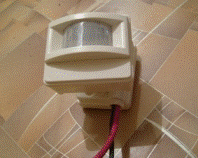 The first association that comes to mind with the phrase “smart home” is the automatic inclusion of light in a room when a person appears there and the automatic lighting off when people exit this room. In this article I will give detailed instructions on how to create such an automatic inclusion of light with your own hands, making your home a little smarter.
The first association that comes to mind with the phrase “smart home” is the automatic inclusion of light in a room when a person appears there and the automatic lighting off when people exit this room. In this article I will give detailed instructions on how to create such an automatic inclusion of light with your own hands, making your home a little smarter.
To implement this idea, the LX-01 motion sensor was taken. The principle of its action is simple - when there is movement in the detection zone, it closes the circuit, thereby including devices connected to it. In the absence of movement, the circuit automatically opens, turning off all devices.
The motion sensor also has the ability to configure, there are three of them - the time interval for switching off, the level of illumination and sensitivity. The time interval for shutdown sets the time during which the sensor will work since the last motion detection. Values are set between 5 seconds and approximately 2 minutes ...
How to determine the number of turns of transformer windings
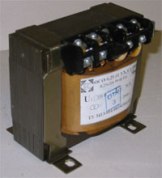 When the type or data of the transformer is not known, the number of turns of each winding can be determined using a multimeter.
When the type or data of the transformer is not known, the number of turns of each winding can be determined using a multimeter.
Using an ohmmeter, determine the location of the terminals of all the transformer windings. If there are gaps between the coil and the magnetic circuit, an additional winding is wound over the windings with a thin wire. The more turns the winding has, the more accurate the measurement results will be.
If there is no space on the transformer coil for an additional winding, then instead of an additional winding, you can use part of the outer winding. To do this, carefully open the outer insulation layer of the coil to gain access to the last layer of the winding, made, as usual, turn to turn. A number of turns are counted from the end of this winding in the “naked” layer. Carefully clean the enamel of the last counted turn.
When measuring, one probe of the voltmeter is connected to the end of the winding, the needle is clamped to the other probe. An ohmmeter measures the resistance of all windings, a winding with high resistance is primary.
In the case when there are still windings with high resistance, one of the windings with low resistance is taken as the primary one and a low alternating voltage is applied to it, for example ...
How to repair a choke for a fluorescent lamp
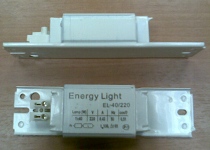 In the article, the author shares his experience in the restoration of chokes, which are part of industrial devices for supplying linear fluorescent lamps. Prices for these chokes can be higher than for fluorescent lamps. Unfortunately, acquiring the required copy of the throttle can be difficult, especially in the "outback. Yes, and it is not always possible to place the product that is offered on the market in the chandelier (shade) of a fluorescent lamp. It can be cheaper, easier and faster to restore an old defective throttle than acquiring new.
In the article, the author shares his experience in the restoration of chokes, which are part of industrial devices for supplying linear fluorescent lamps. Prices for these chokes can be higher than for fluorescent lamps. Unfortunately, acquiring the required copy of the throttle can be difficult, especially in the "outback. Yes, and it is not always possible to place the product that is offered on the market in the chandelier (shade) of a fluorescent lamp. It can be cheaper, easier and faster to restore an old defective throttle than acquiring new.
Tricky probe instead of a tester
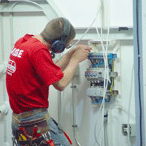 I borrowed this sampler circuit from N. Shilo (Ukraine) in 1984. I don’t know who its author is, but many years of experience using this sampler show that it would be useful to share experience.
I borrowed this sampler circuit from N. Shilo (Ukraine) in 1984. I don’t know who its author is, but many years of experience using this sampler show that it would be useful to share experience.
In my specialty, I deal with electric drives, as well as control circuits for automatic lines, etc. I believe that in nine out of ten cases this probe replaces a regular tester. The probe allows you to evaluate the magnitude and sign ("+", "-", "~") of the voltage in several ranges: up to 36 V,> 36 V,> 110 V,> 220 V, 380 V, as well as ringing electric circuits, such as the contacts of relays, starters, their coils, incandescent lamps, p-n transitions, LEDs, etc., i.e. almost everything that an electrician encounters in the course of his work (with the exception of measuring current).
In the diagram, the switches SA1 and SA2 are shown in a non-pressed state, i.e. in the position of the voltmeter. The magnitude of the voltage can be judged by the number of LEDs in the line VD3 ... VD6, VD1 and VD2 indicate the polarity. Resistor R2 must be made of two or three identical resistors connected in series with a total resistance of 27 ... 30 kOhm. The pressed switch SA2 turns the probe into a classic dial, i.e. battery plus a light bulb. If you press both switches SA1 and SA2, then you can check the circuit in two resistance ranges: - the first range is from 1 MOhm and above to ~ 1.5 kOhm (VD15 is on); - second range - from 1 kOhm to 0 (VD15 and VD16 are lit) ...
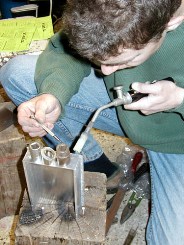 The problems associated with brazing aluminum are explained by the fact that the surface of this metal is covered with a thin, flexible and very strong oxide film - Al2O3. It is not possible to remove it by mechanical methods, because when a clean surface of aluminum comes into contact with air or water, it instantly again becomes covered with an oxide film. Conventional fluxes do not dissolve oxide.
The problems associated with brazing aluminum are explained by the fact that the surface of this metal is covered with a thin, flexible and very strong oxide film - Al2O3. It is not possible to remove it by mechanical methods, because when a clean surface of aluminum comes into contact with air or water, it instantly again becomes covered with an oxide film. Conventional fluxes do not dissolve oxide.
For mechanical cleaning of oxide, it is recommended to clean the surface under a film of oil, but in this case the oil must be completely dehydrated, for which it needs to be heated for some time at a temperature of 150-200 ° C.
It is recommended to use mineral oils, preferably vacuum VM-1, VM-4.
There are tips for using rifle alkaline oil for this purpose, how effective it is is difficult to say, because probably if the oil contains alkali, then water too. There are soldering irons in which a steel scraper is mounted on the sting for cleaning.
It is also proposed to clean the surface with coarse iron filings, which are rubbed over the surface under a layer of oil or rosin with a soldering iron tip, solder, sawdust here act as an abrasive, tinning occurs at the same time, I tried this method, the connection is weak, apparently due to spot tinning aluminum.
Probably a more reliable soldering can be obtained by tinning aluminum over a sublayer of copper electrolytically deposited on the surface of aluminum. Perhaps, for the same purpose, a sublayer of zinc can be used, which is applied in the same way as in the aluminum chromium recipe. The oxide film is more reliably removed by ...
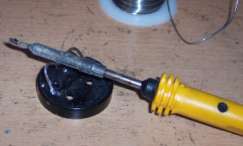 Soldering, fluxes, solders and how to work with a soldering iron? What soldering iron to use, what are the fluxes and solders? And, a little about what a soldering station is ...
Soldering, fluxes, solders and how to work with a soldering iron? What soldering iron to use, what are the fluxes and solders? And, a little about what a soldering station is ...
Not a single serious repair is complete without soldering work. There is a soldering iron in almost every house, and soldering is now a common thing not only for technicians, but also for any amateur home craftsman. Without high-quality soldering, the normal operation of an electronic device (at least a contact on a chandelier, at least a capacitor on a motherboard) sooner or later, with a high probability, will be disrupted. Since during soldering, the solder and the part of the metal to which it is applied are mutually dissolved, after cooling, a rather strong joint is obtained that has good electrical conductivity. But in order for the connection to turn out to be really high-quality and durable, you have to take into account some nuances ...
The main difference between soldering irons is power. For repair of printed circuit boards and installation of small elements sensitive to static voltage, soldering irons with a power of 24-40 watts are used. For soldering wide conductors, power buses and various massive elements - 40-80 watts. Soldering irons of 100 watts or more are mainly used for soldering massive steel structures, especially non-ferrous metals with high thermal conductivity.
Do not forget about the supply voltage ...
About electrical protection devices for "dummies": residual current device (RCD)
 Imagine the following - a washing machine is installed in your bathroom. Whatever the well-known brand, devices of any manufacturer are subject to breakdown, and, say, the most banal thing happens - the insulation on the power cord is damaged and the network potential is on the machine body. And this is not even a breakdown, the car continues to work, but it is already becoming a source of increased danger. After all, if we touch both the car body and the water pipe at the same time, we will close the electric circuit through ourselves. And in most cases it will be fatal.
Imagine the following - a washing machine is installed in your bathroom. Whatever the well-known brand, devices of any manufacturer are subject to breakdown, and, say, the most banal thing happens - the insulation on the power cord is damaged and the network potential is on the machine body. And this is not even a breakdown, the car continues to work, but it is already becoming a source of increased danger. After all, if we touch both the car body and the water pipe at the same time, we will close the electric circuit through ourselves. And in most cases it will be fatal.
To avoid these terrible consequences, RCDs were invented - protective shutdown devices.
An UZO is a high-speed protective switch that responds to differential current in conductors that supply electricity to the protected electrical installation - this is the "official" definition. In a more understandable language, the device will disconnect the consumer from the mains supply if a current leakage occurs to the PE (ground) conductor. Let's consider the principle of operation of the RCD ...
How to make a simple status indicator of a remote lamp
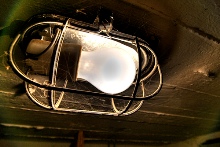 At one time, I was faced with the need to control the burning and integrity of the light bulb when the switch is in another room (for example, a basement, cellar or chicken coop). More than once it happened, the switch is turned on, and the light does not light up: it either burned out, or the contact in the cartridge or switch disappeared. In this case, the switch is located in the corridor, and to the basement, where hens live, you need to go around the house. It is especially bad when, because of this, the bird does not enter the basement in the evening, and then it must be entered manually. The problem was solved by installing a simple and trouble-free device that indicates the flow of current in the circuit of the lighting lamp and is located near the switch.
At one time, I was faced with the need to control the burning and integrity of the light bulb when the switch is in another room (for example, a basement, cellar or chicken coop). More than once it happened, the switch is turned on, and the light does not light up: it either burned out, or the contact in the cartridge or switch disappeared. In this case, the switch is located in the corridor, and to the basement, where hens live, you need to go around the house. It is especially bad when, because of this, the bird does not enter the basement in the evening, and then it must be entered manually. The problem was solved by installing a simple and trouble-free device that indicates the flow of current in the circuit of the lighting lamp and is located near the switch.
The indicator diagram is shown in the figure. When current flows through ballast diodes, a voltage sufficient for the LED to glow is incident on them. You can connect the device at any convenient point in the electrical circuit (before or after the switch) or to break the second wire leading to the lamp.
The indicator is not critical to details. As ballast diodes, you can use any small-sized diodes with an allowable direct current not lower than the current consumption of the illuminator and any operating voltage ...
